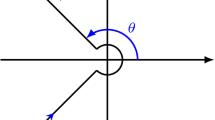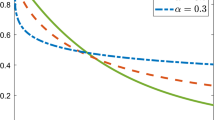Abstract
In this work, we develop an efficient incomplete iterative scheme for the numerical solution of the subdiffusion model involving a Caputo derivative of order \(\alpha \in (0,1)\) in time. It is based on piecewise linear Galerkin finite element method in space and backward Euler convolution quadrature in time and solves one linear algebraic system inexactly by an iterative algorithm at each time step. We present theoretical results for both smooth and nonsmooth solutions, using novel weighted estimates of the time-stepping scheme. The analysis indicates that with the number of iterations at each time level chosen properly, the error estimates are nearly identical with that for the exact linear solver, and the theoretical findings provide guidelines on the choice. Illustrative numerical results are presented to complement the theoretical analysis.
Similar content being viewed by others
References
Alikhanov, A.A.: A new difference scheme for the time fractional diffusion equation. J. Comput. Phys. 280, 424–438 (2015). https://doi.org/10.1016/j.jcp.2014.09.031
Alpert, B., Greengard, L., Hagstrom, T.: Rapid evaluation of nonreflecting boundary kernels for time-domain wave propagation. SIAM J. Numer. Anal. 37(4), 1138–1164 (2000). https://doi.org/10.1137/S0036142998336916
Bramble, J.H., Pasciak, J.E., Sammon, P.H., Thomée, V.: Incomplete iterations in multistep backward difference methods for parabolic problems with smooth and nonsmooth data. Math. Comput. 52(186), 339–367 (1989)
Bramble, J.H., Sammon, P.H.: Efficient higher order single step methods for parabolic problems. I. Math. Comput. 35(151), 655–677 (1980). https://doi.org/10.2307/2006186
Cuesta, E., Lubich, C., Palencia, C.: Convolution quadrature time discretization of fractional diffusion-wave equations. Math. Comput. 75(254), 673–696 (2006). https://doi.org/10.1090/S0025-5718-06-01788-1
Douglas Jr., J., Dupont, T., Ewing, R.E.: Incomplete iteration for time-stepping a Galerkin method for a quasilinear parabolic problem. SIAM J. Numer. Anal. 16(3), 503–522 (1979). https://doi.org/10.1137/0716039
Du, Q., Ming, P.: Cascadic multigrid methods for parabolic problems. Sci. China Ser. A 51(8), 1415–1439 (2008). https://doi.org/10.1007/s11425-008-0112-1
Gaspar, F.J., Rodrigo, C.: Multigrid waveform relaxation for the time-fractional heat equation. SIAM J. Sci. Comput. 39(4), A1201–A1224 (2017). https://doi.org/10.1137/16M1090193
Hackbusch, W.: Multigrid Methods and Applications. Springer, Berlin (1985). https://doi.org/10.1007/978-3-662-02427-0
Jiang, S., Zhang, J., Zhang, Q., Zhang, Z.: Fast evaluation of the Caputo fractional derivative and its applications to fractional diffusion equations. Commun. Comput. Phys. 21(3), 650–678 (2017). https://doi.org/10.4208/cicp.OA-2016-0136
Jin, B., Lazarov, R., Zhou, Z.: Two fully discrete schemes for fractional diffusion and diffusion-wave equations with nonsmooth data. SIAM J. Sci. Comput. 38(1), A146–A170 (2016). https://doi.org/10.1137/140979563
Jin, B., Lazarov, R., Zhou, Z.: Numerical methods for time-fractional evolution equations with nonsmooth data: a concise overview. Comput. Methods Appl. Mech. Eng. 346, 332–358 (2019). https://doi.org/10.1016/j.cma.2018.12.011
Jin, B., Li, B., Zhou, Z.: Correction of high-order BDF convolution quadrature for fractional evolution equations. SIAM J. Sci. Comput. 39(6), A3129–A3152 (2017). https://doi.org/10.1137/17M1118816
Jin, B., Li, B., Zhou, Z.: Discrete maximal regularity of time-stepping schemes for fractional evolution equations. Numer. Math. 138(1), 101–131 (2018). https://doi.org/10.1007/s00211-017-0904-8
Jin, B., Li, B., Zhou, Z.: Subdiffusion with a time-dependent coefficient: analysis and numerical solution. Math. Comput. 88(319), 2157–2186 (2019). https://doi.org/10.1090/mcom/3413
Karaa, S.: Semidiscrete finite element analysis of time fractional parabolic problems: a unified approach. SIAM J. Numer. Anal. 56(3), 1673–1692 (2018). https://doi.org/10.1137/17M1134160
Keeling, S.L.: Galerkin/Runge-Kutta discretizations for parabolic equations with time-dependent coefficients. Math. Comput. 52(186), 561–586 (1989). https://doi.org/10.2307/2008483
Kilbas, A.A., Srivastava, H.M., Trujillo, J.J.: Theory and Applications of Fractional Differential Equations. Elsevier, Amsterdam (2006)
Lin, X.L., Lu, X., Ng, M.K., Sun, H.W.: A fast accurate approximation method with multigrid solver for two-dimensional fractional sub-diffusion equation. J. Comput. Phys. 323, 204–218 (2016). https://doi.org/10.1016/j.jcp.2016.07.031
Lin, Y., Xu, C.: Finite difference/spectral approximations for the time-fractional diffusion equation. J. Comput. Phys. 225(2), 1533–1552 (2007). https://doi.org/10.1016/j.jcp.2007.02.001
Lubich, C.: Discretized fractional calculus. SIAM J. Math. Anal. 17(3), 704–719 (1986)
Lubich, C., Schädle, A.: Fast convolution for nonreflecting boundary conditions. SIAM J. Sci. Comput. 24(1), 161–182 (2002). https://doi.org/10.1137/S1064827501388741
Lubich, C., Sloan, I.H., Thomée, V.: Nonsmooth data error estimates for approximations of an evolution equation with a positive-type memory term. Math. Comput. 65(213), 1–17 (1996). https://doi.org/10.1090/S0025-5718-96-00677-1
McLean, W., Mustapha, K.: Convergence analysis of a discontinuous Galerkin method for a sub-diffusion equation. Numer. Algorithms 52(1), 69–88 (2009). https://doi.org/10.1007/s11075-008-9258-8
Metzler, R., Jeon, J.H., Cherstvy, A.G., Barkai, E.: Anomalous diffusion models and their properties: non-stationarity, non-ergodicity, and ageing at the centenary of single particle tracking. Phys. Chem. Chem. Phys. 16(44), 24128–24164 (2014)
Metzler, R., Klafter, J.: The random walk’s guide to anomalous diffusion: a fractional dynamics approach. Phys. Rep. 339(1), 1–77 (2000)
Mustapha, K., Abdallah, B., Furati, K.M.: A discontinuous Petrov-Galerkin method for time-fractional diffusion equations. SIAM J. Numer. Anal. 52(5), 2512–2529 (2014)
Saad, Y.: Iterative Methods for Sparse Linear Systems, 2nd edn. SIAM, Philadelphia (2003). https://doi.org/10.1137/1.9780898718003
Stynes, M., O’Riordan, E., Gracia, J.L.: Error analysis of a finite difference method on graded meshes for a time-fractional diffusion equation. SIAM J. Numer. Anal. 55(2), 1057–1079 (2017). https://doi.org/10.1137/16M1082329
Sun, Z.Z., Wu, X.: A fully discrete difference scheme for a diffusion-wave system. Appl. Numer. Math. 56(2), 193–209 (2006). https://doi.org/10.1016/j.apnum.2005.03.003
Thomée, V.: Galerkin Finite Element Methods for Parabolic Problems, 2nd edn. Springer, Berlin (2006)
Toselli, A., Widlund, O.: Domain Decomposition Methods-Algorithms and Theory. Springer, Berlin (2005). https://doi.org/10.1007/b137868
Author information
Authors and Affiliations
Corresponding author
Additional information
Publisher's Note
Springer Nature remains neutral with regard to jurisdictional claims in published maps and institutional affiliations.
The work of B. Jin is partially supported by UK EPSRC EP/T000864/1, and that of Z. Zhou by Hong Kong RGC Grant No. 25300818.
Appendices
Appendix A: Basic estimates
Lemma 11
For \(\beta ,\gamma \ge 0\), there holds
Proof
We denote by \([\cdot ]\) the integral part of a real number. Then
Then, by the trivial inequalities: for \(1\le i\le [{n/2}] \), there holds \((n+1-i)^{-\beta }\le cn^{-\beta }\) and for \([{n/2}]+1\le i\le n\), there holds \(i^{-\gamma }\le cn^{-\gamma }\), we deduce
Simple computation gives \(\sum _{i=1}^ji^{-\gamma }\le cj^{\max (1-\gamma ,0)}\) if \(\gamma \ne 1\) and \(\sum _{i=1}^ji^{-1}\le c\ln (j+1)\). Combining these estimates yields the desired assertion.\(\square \)
Next we give an upper bound on the CQ weights \(b_j^{(\alpha )}\).
Lemma 12
For the weights \(b_j^{(\alpha )}\), \(|b_j^{(\alpha )}| \le e^{2\alpha }(j+1)^{-\alpha -1}\).
Proof
The weight \(b_j^{(\alpha )}\) is given by \(b_0^{(\alpha )}=1\) and \(b_j^{(\alpha )}= -\varPi _{\ell =1}^j(1-\frac{1+\alpha }{\ell })\) for any \(j\ge 1\). Note the elementary inequality \(\ln (1-x)\le -x\) for any \(x\in (0,1)\), and the estimate \(\sum _{\ell =1}^j\ell ^{-1}\ge \int _1^{j+1}s^{-1}\mathrm{d}s = \ln (j+1).\) Since \(\ln \alpha = \ln (1-(1-\alpha ))\le \alpha -1\), for any \(j\ge 1\),
This completes the proof of the lemma. \(\square \)
Appendix B: Proof of Lemmas 4 and 5
In this part, we provide the proof of Lemmas 4 and 5. The proof of Corollary 1 is identical with that for Lemma 5 and thus it is omitted. The proof relies on the discrete Laplace transform, and the following two well-known estimates
and the resolvent estimate: for any \(\theta \in (\pi /2,\pi )\),
Now we can give the proof of Lemma 4.
Proof of Lemma 4
By Laplace transform, \(w_h(t_n)={\bar{\partial }}_\tau ^2 u_h(t_n)\) is given by
We split the contour \(\varGamma _{\theta ,\delta }\) into \(\varGamma _{\theta ,\delta }^\tau \) and \(\varGamma _{\theta ,\delta } {\setminus }\varGamma _{\theta ,\delta }^\tau \), and denote the corresponding integral by \(\mathrm{I}\) and \(\mathrm{II}\), respectively. We discuss the cases \(v\in L^2(\varOmega )\) and \(v\in D(A)\), separately.
Case (i): \(v\in L^2(\varOmega )\). By (B.1) and (B.3), \(\Vert K(z)\Vert \le c\) for \(z\in \varGamma _{\theta ,\delta }^\tau \). Then choosing \(\delta =c/t_n\) in \(\varGamma _{\theta ,\delta }^\tau \) gives
For any \(z=\rho e^{\pm \mathrm {i}\theta }\in \varGamma _{\theta ,\delta }{\setminus }\varGamma _{\theta ,\delta }^\tau \), by the estimates (B.2) and (B.3), \( \Vert K(z)\Vert \le ce^{2\rho \tau }.\) By choosing \(\theta \in (\pi /2,\pi )\) sufficiently close to \(\pi \), we deduce
Thus, \(\Vert {\bar{\partial }}_\tau ^2u_h(t_n)\Vert \le c t_n^{-2}\Vert v_h\Vert _{L^2(\varOmega )}.\) Next, by the identity \(A_h(z^\alpha +A_h)^{-1}=I-z^\alpha (z^\alpha +A_h)\) and (B.3), \(\Vert A_hK(z)\Vert \le |z|^{\alpha -1}\) for \(z\in \varSigma _\theta \). Then repeating the argument gives
Then the assertion for the case \(v\in L^2(\varOmega )\) follows from the triangle inequality.
Case (ii): \(v\in D(A)\). Simple computation gives the identity \(K(z)v_h=z^{\alpha -1}(z^\alpha +A_h)^{-1}v_h = z^{-1}v_h - z^{-\alpha }(z^\alpha +A_h)^{-1}A_hv_h\). Thus, we have
in which we split the contour \(\varGamma _{\theta ,\delta }\) into \(\varGamma _{\theta ,\delta }^\tau \) and \(\varGamma _{\theta ,\delta }{\setminus } \varGamma _{\theta ,\delta }^\tau \), and accordingly the integral. Then the rest of the proof follows from the estimates (B.1), (B.2) and (B.3) as before.\(\square \)
Last, we prove Lemma 5.
Proof of Lemma 5
By Laplace transform and its discrete analogue, we have
with \(K(z)=(\delta _\tau (e^{-z\tau })^{\alpha }-z^\alpha )z^{ -1} (z^\alpha +A_h)^{-1}\). Recall the following estimate:
Then by choosing \(\delta =c/t_n\) in the contour \(\varGamma _{\theta , \delta }^\tau \) and the resolvent estimate (B.3), we obtain
Further, by (B.2), for any \(z=\rho e^{\pm \mathrm {i}\theta }\in \varGamma _{\theta ,\delta }{\setminus }\varGamma _{\theta ,\delta }^\tau \) and choosing \(\theta \in (\pi /2,\pi )\) close to \(\pi \),
Then we deduce
Thus, we show the assertion for \(\beta =0\). For the case \(\beta =1\), the identity \(A_h(z^\alpha +A_h)^{-1}=I- z^\alpha (z^\alpha +A_h)\), (B.3) and (B.4) give
and the bound on \(\Vert A_h\mathrm{II}\Vert _{L^2(\varOmega )}\) follows analogously, completing the proof for \(\beta =1\). Then the case \(\beta \in (0,1)\) follows by interpolation. This shows part (i). The proof of part (ii) is similar and applies the \(L^2(\varOmega )\) stability of \(P_h\), and hence the detail is omitted. \(\square \)
Rights and permissions
About this article
Cite this article
Jin, B., Zhou, Z. Incomplete iterative solution of subdiffusion. Numer. Math. 145, 693–725 (2020). https://doi.org/10.1007/s00211-020-01128-w
Received:
Revised:
Published:
Issue Date:
DOI: https://doi.org/10.1007/s00211-020-01128-w




